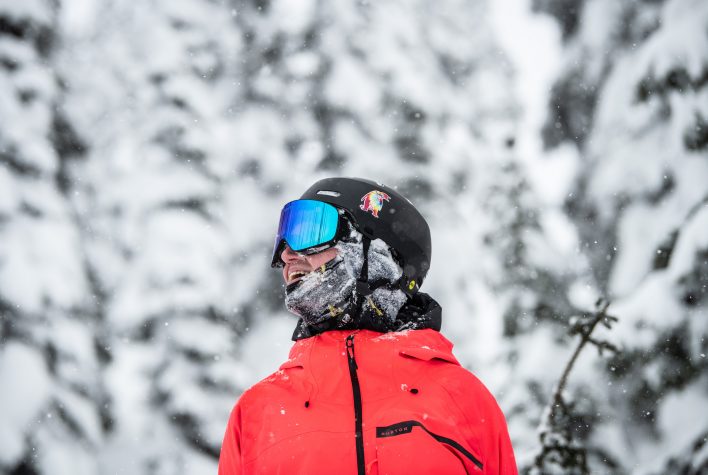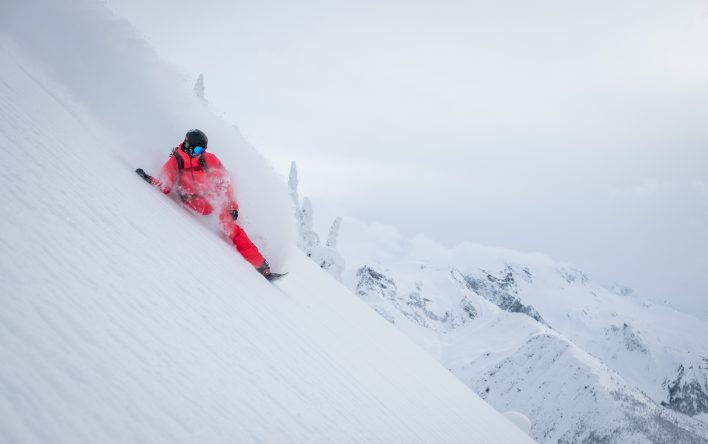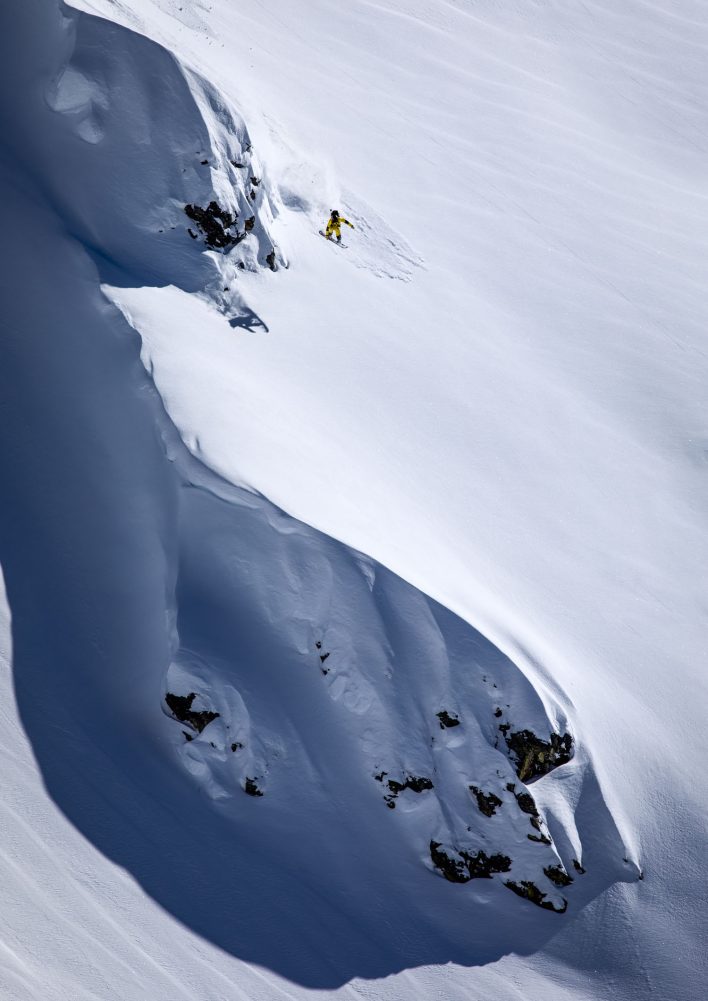
Tim van der Krogt isn’t the type to wing it. The emerging Revelstoke, B.C., freerider and splitboard mountaineer is a methodical learner who gains the requisite knowledge and practices the necessary skills. He’s not afraid to ask for a hand, either. “He’s great at finding people that can help him and just approaching them,” climbing partner Christopher Wills says. “He’s not afraid to do that, and he does it in a really tactful way.”
Unless you’re deep in the Revelstoke snowboarding scene, van der Krogt might not be a household name, but the 25-year-old Canadian native is quickly setting a standard for backcountry freeriding as part of Weston’s athlete team. Sean Eno, the company’s marketing manager, wrote in an email, “The dude is sending four stacks of pillows on a split like it’s nothing at all. He’s definitely pushing the limits of what freestyle looks like in the backcountry—not many people are willing to throw down as hard as him on man powered missions with a splitty.”
Van der Krogt’s evolution has been, like his learning style, methodical. After his family moved to Big White, a resort town southeast of Kelowna, B.C., when he was nine, he became immersed in snowboarding. Houses in Big White are speckled under the lifts and the community’s school is below them, so he used to snowboard to school. With no class on Fridays, he and his friends had long weekends to rip around the resort. Unlike many professional riders, he didn’t grow up on a race or freeride team, in part because Big White’s wintertime kid population of about 40 didn’t support such programs. Instead, he had three days a week to ride with his friends.
In contrast with the inbounds areas three hours north in Revelstoke, Big White’s terrain isn’t awe inspiring, so the resort is better known for family-friendly skiing and its terrain park. Though the park wasn’t his “main thing,” van der Krogt says, he used it to hone tricks he could take to a couple of sidecountry areas.
“There used to be an older crew that would go and hit that stuff,” he says. “And we would watch them and aspire to be them and think they were so badass.” Eventually, his group became the older crew, and they got more comfortable in those zones, though upon reflection the terrain doesn’t seem as intimidating as it once did. “Now we go back and look at those sidecountry areas, and they’re just flat and boring and not that exciting. But that was kind of where the progression from freestyle to wanting to get into the backcountry started.”

Van der Krogt landed in Revelstoke five years ago, when he was 20, after spending time in Norway, Japan and New Zealand. Though he’d had a splitboard since he was 17, and the British Columbia town is a mecca of backcountry riding and mountaineering, he didn’t immediately start ticking off big lines. He bought a guidebook for Rogers Pass, he says, but “I opened it and looked at it, and I closed it straight away because everything in there was way too intimidating.”
Remember, van der Krogt isn’t the type to jump in without feeling prepared. A few years ago, he joined a crew of French splitboarders in Revelstoke who acted as mentors, helping him take his first real tours. At first, there were some language barriers. “We’d go out and they’d all be speaking in French, and the only word that I would understand would be avalanche,” he says, laughing. After asking them to switch to English, he started gleaning information on traveling in the mountains that his introductory avalanche courses didn’t cover.
When the Covid pandemic started, the French riders went back home, and van der Krogt found a new pack of partners whose skills and experience matched his. He didn’t work last winter, riding every day, becoming more comfortable and spending lots of time on the skintrack, while still finding cliff zones and pillows for photo shoots and freeriding. Even as he established a reputation as a strong backcountry freestyle rider, he set his sights on more technical terrain, including Mt. Begbie’s Elevator Shaft, a steep, skinny strip on the peak that looms over Revelstoke.
He knew the line would require rope work, so he had started building the needed skillset in the summers, linking up with Wills, a mountaineer and climber. Once van der Krogt was comfortable with multipitch climbing, the pair turned to winter ascents, practicing rappels and anchors on trees. “That really pushed me into pretty complex terrain for sure,” Wills says of their partnership.
When van der Krogt started researching the Elevator Shaft, the few people in Revelstoke with beta told him to centerpunch it, to bootpack up the gut, but, worried about the cornice up top, he wanted to drop into it. So, van der Krogt and his crew climbed around to the top, and he volunteered to cut the cornice and go in first. The reward? “I hadn’t been scared for a while, and it managed to scare me because it was steep and it was tight,” he says. “But there was good snow on it.”
Along with the Elevator Shaft, van der Krogt notched the Grizzly Couloir on Rogers Pass, a ribbon on Grizzly Mountain barely wider than a snowboard at times, and the Jupiter Traverse, a three-peak Rogers Pass classic. Extending himself into those bigger objectives, along with his penchant for stomping pillow lines, grabbed the attention of Weston, which van der Krogt was understandably excited about.

Following his productive winter, van der Krogt turned to another interest—journalism. As you’d expect, he simply contacted the editor of the Revelstoke Review and said he wanted to learn about writing. Now, a quick search of the Review’s website shows that van der Krogt has dozens of bylines. “He’s really proactive about just getting out there,” Wills said.
On the snowboarding side, however, van der Krogt hasn’t returned to the same level as last winter. He sustained a head injury mountain biking this past summer, and is being methodical about his return. Riding technical slopes with significant exposure requires a fully functioning brain, so as of late January, van der Krogt hadn’t jumped back into big tours yet. Part of being a pro rider, he’s learning, is taking care of his body, but he has his eye on resort-adjacent bowls for freestyle spots and tours to get back into things. Given his measured approach, he won’t push too hard too fast, but he plans on coming back with the same mix of big air and big lines that defined his last season.
“I’m getting out there now, and I’m slowly going to be able to start doing more and more,” he says. “I’m not gonna sit around all season. I’ll be able to get after it.”
This story was originally published in Backcountry Magazine No. 145 (The Generations Issue) as part of “The Kids are All Right,” a series of profiles on up-and-coming athletes. To read more, pick up a copy at BackcountryMagazine.com/145 or subscribe.










Related posts: